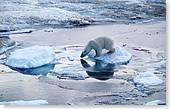15 Sep 2008
Arctic sea ice may well have reached its lowest volumes ever, as summer ice coverage of the Arctic Sea looks set to be close to last year’s record lows, with thinner ice overall.
Final figures on minimum ice coverage for 2008 are expected in a matter of days, but they are already flirting with last year’s record low of 1.59 million square miles, or 4.13 million square kilometres.
“If you take reduced ice thickness into account, there is probably less ice overall in the Arctic this year than in any other year since monitoring began,” said Martin Sommerkorn, WWF International Arctic Programme’s Senior Climate Change Advisor.
“This is also the first year that the Northwest Passage over the top of North America, and the Northeast Passage over the top of Russia are both free of ice.”
Dr. Sommerkorn said the continuing loss of older, thicker ice means that the Arctic ice cover is following a trend of becoming younger and thinner each year.
The area of ice that is at least five years old has decreased by 56 per cent between 1985 and 2007. The oldest ice types have essentially disappeared.
Taken together, the new figures clearly show the Arctic is experiencing the continuation of an accelerated declining trend.
“We are expecting confirmation of 2008 being either the lowest or the second-lowest year in terms of summer ice coverage,” Dr. Sommerkorn said.
“This means two years in a row of record lows since we started recording Arctic sea ice coverage, and a continuing catastrophic downward trend.
“There are already signs that species such as polar bears are experiencing negative effects as climate change erodes the ice platform on which they rely.
These changes are also affecting the peoples of the Arctic whose traditional livelihoods depend on healthy ecosystems.”
The trend of melting Arctic ice is also alarming for the rest of the world. “The Arctic is a key factor in stabilising the global climate,” Dr Sommerkorn said.
“Arctic ice is like a mirror, reflecting the sun’s heat back into space. As that ice goes, Arctic waters absorb more heat, adding to global warming.
“The local warming of the Arctic will also soon release more greenhouse gases from the Arctic that were previously locked in permanently frozen ground.
“This means there will be two powerful feedbacks from the Arctic affecting the global environment. This is not just an Arctic problem, it is a global problem, and it demands a global response.”
The governments of the world are currently negotiating a new climate agreement to come into force from 2013 when the first phase of the Kyoto Protocol has ended.
“Governments must speed up these talks and ensure to agree the new climate deal at the UN Summit in Copenhagen in December 2009, just fifteen months from now, Dr Sommerkorn said.

0 comments:
Post a Comment